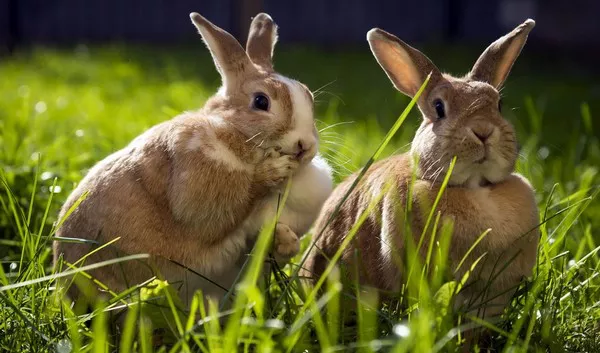Wild rabbits are enchanting creatures that play a vital role in maintaining the balance of ecosystems. Their natural diet consists mainly of grasses, herbs, and other vegetation. As stewards of the environment, understanding the preferred plants for wild rabbits can help conservationists and nature enthusiasts support these furry inhabitants. In this article, we delve into eight plants that not only make for a delectable meal for wild rabbits but also contribute to their overall well-being.
Clover (Trifolium spp.): A Nutrient-Rich Forage
Clover, with its trifoliate leaves, is a staple in the diet of wild rabbits. It is not only abundant but also a nutrient-rich forage option. Clover provides essential vitamins and minerals, including vitamin C, vitamin K, and calcium, promoting the overall health of wild rabbits. However, it’s crucial to be mindful of the species, as some varieties may be toxic. Red clover and white clover are generally safe and well-loved by rabbits.
Dandelion (Taraxacum officinale): A Common Delight
Often dismissed as a pesky weed, the dandelion is a common delight for wild rabbits. Its leaves are rich in vitamins A, C, and K, while the roots provide a good source of fiber. Additionally, dandelion acts as a natural diuretic, aiding in the prevention of urinary issues in rabbits. To support the local rabbit population, consider allowing dandelions to flourish in areas where rabbits roam.
Plantain (Plantago spp.): The Medicinal Herb
Plantain, a broad-leafed herb, is not only a medicinal plant for humans but also a valuable addition to a wild rabbit’s diet. High in fiber, plantain aids in digestion and helps prevent gastrointestinal issues in rabbits. Moreover, it possesses anti-inflammatory properties, promoting overall well-being. Wild rabbits instinctively seek out plantain for its nutritional and medicinal benefits.
Meadow Grasses: A Natural Grazing Ground
Meadow grasses, comprising various grass species like Timothy grass and Kentucky bluegrass, serve as a natural grazing ground for wild rabbits. These grasses are not only abundant but also offer a well-balanced mix of nutrients. Rich in fiber, meadow grasses contribute to dental health, preventing dental issues that can be common in rabbits. Encouraging the growth of meadow grasses supports the natural habitat of wild rabbits.
Chicory (Cichorium intybus): A Bitter-Sweet Delight
Chicory, known for its bitter taste, is a favorite among wild rabbits. This plant provides a good dose of vitamins A and C, as well as essential minerals like manganese and potassium. The bitterness of chicory can be beneficial for a rabbit’s digestive system, promoting the secretion of digestive enzymes. Including chicory in the landscape ensures a diverse and palatable diet for wild rabbits.
Raspberry (Rubus idaeus): Berries for the Bunny
Rabbits enjoy nibbling on raspberry plants, which offer more than just tasty berries. Raspberry leaves are high in fiber and contain essential nutrients like calcium and magnesium. These leaves contribute to maintaining healthy teeth and bones in wild rabbits. While the sweet berries are a bonus, the leaves make raspberry plants a valuable addition to the wild rabbit’s menu.
See Also:How Long Should I Syringe Feed My Rabbit?
Borage (Borago officinalis): A Nutrient-Packed Herb
Borage, with its vibrant blue flowers and hairy leaves, is a nutrient-packed herb that wild rabbits find irresistible. Rich in gamma-linolenic acid (GLA), borage supports skin and coat health in rabbits. The leaves are also high in calcium and potassium, essential for maintaining strong bones and a well-functioning circulatory system. Planting borage in wild rabbit habitats enhances their diet with a variety of nutrients.
Mint (Mentha spp.): A Flavorful Treat
Mint, with its aromatic leaves, is a flavorful treat that wild rabbits appreciate. While it should be offered in moderation due to its potent aroma, mint provides a refreshing addition to a rabbit’s diet. Mint is known to have calming properties, which can benefit wild rabbits in their natural environment. The leaves of mint plants contain vitamins and minerals that contribute to overall health, making it a delightful and beneficial choice.
Conclusion:
In conclusion, understanding the preferred plants for wild rabbits is essential for supporting their well-being and contributing to the ecological balance. By incorporating a variety of safe and nutritious plants into their habitat, conservationists and nature enthusiasts can play a crucial role in sustaining wild rabbit populations. Creating environments rich in diverse vegetation ensures that these enchanting creatures have access to a natural buffet that meets their dietary needs, ultimately fostering a healthier and more vibrant ecosystem.
Related Topics:
How to Feed Medicine to Rabbit?
Critical Care for Rabbits: Preparation and Supportive Measures
Syringe Feeding for Rabbits: Quantity and Best Practices



























